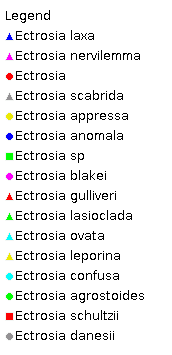Ectrosia Prodr. 185 (1810).
Derivation:. From Greek ectrosis (miscarriage), alluding to the fact that only the basal 1 or 2 florets are fertile.
Taxonomic revisions, nomenclatural references:. C.E.Hubbard, Hookers Icones Plantarum 34: t.3312: 1–16 (1936)
Key references (keys and floras):. G.Bentham, Flora Australiensis 7: 633–634 (1878); C.A.Gardner, Flora of Western Australia 1 Gramineae 86–89 (1952); E.E.Henty, Manual Grasses New Guinea 84 (1969); M.Lazarides, Tropical Grasses S.E.Asia 170–171 (1980); J.C.Tothill and J.B.Hacker, Grasses Southern of Queensland 210–211 (1983); M.Lazarides, F.Quinn and J.Palmer, Flora of the Kimberley Region 1155–1156 (1992); B.K.Simon, Key to Australian Grasses 106–107 (1993); D.Sharp and B.K.Simon, AusGrass (2002) and as Planichloa; K.Mallet (ed.), Flora of Australia 44B: Poaceae 3: 426–439 (2005).
W.D.Clayton & S.A.Renvoize, Genera Graminum (1986), genus (363).
Native. 12 species, from tropical Australia and New Guinea. 13 species in Australia, WA, NT, and Qld. Also Malesia.
Habit. Annual or perennial, tufted. Leaf blades narrow. Ligule a fringed membrane (very narrow) or a fringe of hairs.
Inflorescence. Inflorescence paniculate (or almost reduced to a raceme of racemes), an open panicle with branches ending in single spikelets, open to contracted, non-digitate.
Spikelets. Spikelets laterally compressed, more than 2 flowered, with 1 fertile floret or with 2 or more fertile florets, awned, solitary, pedicelled; with naked rachilla extension. Fertile spikelets disarticulating above glumes, with distinctly elongated rachilla internodes between florets (the one above the glumes shorter than the rest).
Glumes. Glumes unequal, shorter than spikelet, shorter than adjacent lemmas or long relative to adjacent lemmas, hairless, glabrous, pointed or blunt, awnless, keeled, similar. Lower glume 1 nerved. Upper glume 1 nerved.
Florets. Fertile florets 1–20. Lemmas similar in texture to glumes (thinly membranous), not becoming indurated, entire at apex or incised, when entire pointed or blunt, awned or muticous (rarely - E. blakei), without a germination flap, 1–3 nerved, glabrous or scabrous, 1 keeled. Awns 1, from a sinus or apical, non-geniculate, hairless (scabrous), much shorter than body of lemma to much longer than body of lemma. Palea relatively long, entire, 2 nerved, strongly 2 keeled. Palea keels wingless, hairy (ciliate). Distal incomplete florets specialised and modified (long-awned, or reduced to awns). Lodicules 2. Stamens 3. Grain small, ellipsoid. Hilum short. Embryo large.
Kranz Anatomy. C4.
Habitat. Poor sandy soils. Species of open habitats.
Classification. Chloridoideae; Cynodonteae.
Notes. The genus is readily recognised by the modification of its upper floret into a dispersal device (Clayton and Renvoize, 1986). Ectrosia, Planichloa and Heterachne form a continuum of variation and their recognition as separate entities requires further analysis (B.K.Simon).
Types Species. E. leporina R.Br.
Biogeographic Element. Clifford & Simon 1981, Simon & Jacobs 1990: Australasian.


